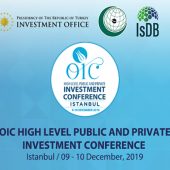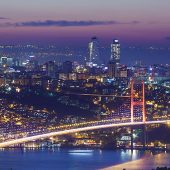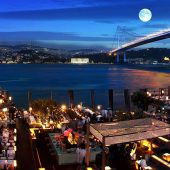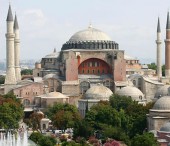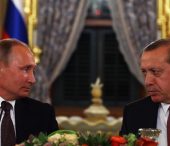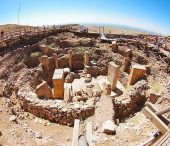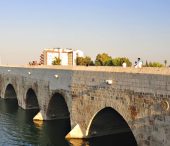Trabzon is a city on the Black Sea coast of north-eastern Turkey and the capital of Trabzon Province. Trabzon, located on the historical Silk Road became a melting pot of religions, languages and culture for centuries and a trade gateway to Iran in the east, Russia and the Caucasus to the North. Venetian and Genoese paid visit and sold silk, linen and woolen fabric. During the Ottoman period Trabzon, because of the importance of its port, became a focal point of trade to Iran, India and the Caucasus. Trabzon formed the basis of several states in its long history, and was the capital city of the Empire of Trebizond. The population of the city is 768.417 (2015 census).
Ancient and Mediaeval
Originally, it was founded as Trebizond by Greek traders from Miletus (traditionally in 756 BC).
The city was one of a number (about ten) of Milesian emporia, or trading colonies along the shores of the Black Sea. Others include Sinope, Abydos and Cyzicus (in the Dardanelles). Like most Greek colonies, the city was a small enclave of Greek life, and not an empire unto its own, in the later European sense of the word.
Trebizond's trade partners included the Mossynoeci. When Xenophon and the "ten thousand" Greek mercenaries were fighting their way out of Persia, the first Greek city they reached was Trebizond (Xenophon, Anabasis, 5.5.10). The city and the local Mossynoeci had become estranged from the Mossynoecian capital, to the point of civil war. Xenophon's force resolved this in the rebels' favor, and so in Trebizond's interest.
The city was added to the kingdom of Pontus by Mithridates VI Eupator and it became home port for the Pontic fleet.
When the kingdom was annexed to the Roman province of Galatia in 64–65, the fleet passed to new commanders, becoming the Classis Pontica. Trebizond gained importance under Roman rule in the 1st century for its access to road leading over the Zigana Pass to the Armenian frontier or the upper Euphrates valley. New roads were constructed from Persia and Mesopotamia under the rule of Vespasian, and Hadrian commissioned improvements to give the city a more structured harbor. A mithraeum now serves as a crypt for the church of Panaghia Theoskepastos in nearby Kizlara, east of the citadel and south of the modern harbor. The city was pillaged by the Goths in 258, and, although it was afterwards re-built, Trebizond did not recover until the trade route regained importance in the 8th to 10th centuries.
After the Fourth Crusade in 1204, a Byzantine successor state was founded there with support of Queen Tamar of Georgia, the Empire of Trebizond, which ruled part of the Black Sea coast from Trebizond until 1461, when its ruler, David, surrendered to Mehmed II, ruler of the Ottoman Empire. Following this takeover Mehmed sent many Turkish settlers into the area, but the old ethnic Armenian, Greek and Laz communities remained. During the late Ottoman period, the city had a great Christian influence in terms of culture, and a wealthy merchant class who created several Western consulates.
Modern era
Ortahisar neighbourhood in winterIn 1901 the harbour was equipped with cranes by Stothert and Pitt of Bath in England. The city was the site of one of the key battles between the Ottoman and Russian armies during the Caucasus Campaign of World War I which resulted in the capture of Trebizond by the Russian army under command of Grand Duke Nicholas and Nikolai Yudenich in April 1916. Following the Treaty of Sèvres and subsequent Treaty of Lausanne, Trebizond again became a part of Turkey. After World War I, European publications increasingly adopted local names for Turkish cities rather than traditional forms of Greek or Italian origin, and Trebizond became known to English-language readers as Trabzon.
During World War II shipping activity was limited because the Black Sea had again become a war zone. Hence the most important export products, tobacco and hazelnut, could not be sold and living standards degraded.
As a result of the general development of the country, Trabzon has developed its economic and commercial life. The Coastal Highway and a new harbour have increased commercial relations with Central Anatolia, which has led to some growth. However, progress has been slow in comparison with the western and the southwestern parts of Turkey.
Trabzon is famous throughout Turkey for its anchovies, which are the main meal in many restaurants in the city. Major exports from Trabzon are hazelnuts and tea.
The city still has a sizable community of Greek-speaking Muslims, most of whom are originally from the vicinities of Tonya and Of. However, the Pontic Greek language (known as Ποντιακά, Pontiaka) is spoken mostly by the older generations.
Trabzon is known as a stronghold of ultra-nationalistic political currents in Turkey. In April 2006, Catholic priest Andrea Santoro was murdered in his church in Trabzon. Ogün Samast, the suspect in the January 2007 murder of Armenian intellectual Hrant Dink, is from Trabzon.
Geography and climate
The province has a total area of 4.685 km² and it is bordered by the provinces of Rize, Giresun and Gümüşhane. The total area is 22,4% plateaux and 77,6% hills.
Rivers
The Değirmendere (former Piksidis), Yanbolu, Fol, Karadere, Koha, Sürmene (former Manahos), Solaklı, Baltacı and İyidere (former Kalopotamos)
Lakes
Çakırgöl, Uzungöl, Serra Gölü
Climate
Trabzon has a typical Black Sea climate, with rain the year round and temperatures reaching up to around 27°C in the summer. Winters are cool and damp, and the lowest temperature is around 5°C in January. The water temperature fluctuates between 10°–20°C throughout the year.
People
Greek has been spoken in the region since early antiquity. The local dialect developed along its own lines and is today partly intelligible to speakers of Standard Greek. It was spoken mainly by a Greek Orthodox population up until the population exchange; nearly all speakers are now Muslim. Laz people also live in Trabzon.
The Chepnis, an Oghuz tribe that played an important role in the history of the Eastern Black Sea area in the 13th and 14th centuries, live in the Şalpazarı (Ağasar valley) region of the Trabzon Province.
There was an Armenian community in Trebizond as early as the 7th century. During the Mongol invasions of the 13th and 14th centuries, numerous Armenian families fled here from Ani. According to Ronald C. Jennings, in the early 1500s, Armenians made up approximately 13 percent of the city's population, and they numbered roughly equal to the Muslims in the city in that period. In the late 19th century the Armenian community was persecuted during the Hamidian massacres. Prior to WWI, a sizable Armenian community of 30,000 was present in the city. During the Armenian Genocide, most were killed or deported. Following the Russian capture of Trabzon in April 1916, some 500 Armenian survivors, as well as monks of the local Armenian monastery returned. They remained there till after the war.
Trabzon has a sizeable Russian minority, who began emigrating to the region after the dissolution of the Soviet Union. Russian language shops and facilities can be found in the town. Russians are generally subject to stereotypes and suspicion. A subset of Russian women work in the local prostitution industry and are thus derisively known as "Natashas" by Trabzonites.
Because of the presence of Karadeniz Technical University, Trabzon hosts students from all over Turkey, especially the East and the Black Sea region, as well as students from Central Asian states.
Origin of the Pontic Turks and Greeks
Very little has been written on the Turkification of the area. There are no historical records of any considerable Turkish-speaking groups in the Trabzon area until the late 15th century, with the exception of the Chepnis. The original Greek (and in some regions Armenian) speakers imposed features from their mother language into Turkish. Heath W. Lowry's work about Ottoman tax books (Tahrir Defteri) with Halil İnalcık claims that most Turks of Trabzon city are of Greek origin.
It is possible that the majority of the population of Trabzon and Rize (and other ancient Greek colonies in the Pontus region) — except up to the time of the Chepni Turk immigration waves — consisted of indigenous Caucasian tribes (the Colchians and the Laz) who had been partly Hellenized religiously and linguistically. Michael Meeker stresses the cultural resemblances (e.g. in village structure, house types, and pastoral techniques) between the Eastern Black Sea coast and the areas in the Caucasus proper.
Tourist attractions
Trabzon has a number of tourist attractions, some of them dating back to the times of the ancient empires that once existed in the region. In the city itself, one can find a hub of shops, stalls and restaurants surrounding the "Meydan", a square in the center of the city, which includes a tea garden.
The Hagia Sophia (Turkish: Ayasofya Müzesi), a stunning Byzantine church, is probably the town's most important tourist attraction.
Trabzon Castle ruins are visible in the town but cannot be visited as they fall in a military zone. The outside wall of the castle now serves as the back wall of a military building.
Atatürk Köşkü is a lovely Victorian-era villa, which was given to Atatürk when he visited Trabzon in 1924. It houses period rooms and acts as a shrine to the memory of the Turks' beloved great leader.
Boztepe Park is a small park and tea garden on the hills above Trabzon that has a panoramic view of nearly the entire city. The terrain in Trabzon is such that although the view is far above that of the buildings below, it is still close enough to be able to observe the flow of traffic and the people moving about in the city.
Trabzon Museum is located in the town center and offers interesting exhibits on the history of the region, including an impressive collection of Byzantine-era artifacts.
Trabzon's Bazaar District offers interesting shopping opportunities on ancient narrow streets, continuing from Kunduracilar Street from the Meydan (town square).
Kostaki Mansion is located ob the north of Zeytinlik near Uzun Sokak.
Within Trabzon Province, the main attractions are the Sümela Monastery and Uzungöl. The monastery is built on the side of a very steep mountain overlooking the green forests below and is about 50km south of the city. Uzungöl is famous for the natural beauty of the area and the amazing scenery.
Other important sites of interest include: Kaymaklı Monastery, Kızlar (Panagia Theoskepastos) Monastery, Kuştul (Gregorios Peristera) Monastery, Kızlar (Panagia Kerameste) Monastery, Vazelon Monastery, Hagios Savvas (Maşatlık) Cave Churches, Hagia Anna (Little Ayvasıl), Sotha (St. John), Hagios Theodoros, Hagios Konstantinos, Hagios Khristophoras, Hagios Kiryaki, Santa Maria, Hagios Mikhail and Panagia Tzita churches, Fatih Mosque (originally the Panagia Khrysokephalos Church), Yeni Cuma Mosque (originally the Hagios Eugenios Church), Nakip Mosque (originally the Hagios Andreas Church), Hüsnü Köktuğ Mosque (originally the Hagios Eleutherios Church), İskender Pasha Mosque, Semerciler Mosque, Çarşı Mosque, and the Gülbahar Hatun Mosque and Türbe.
Food
Trabzon regional cuisine is traditionally reliant on fish, especially Hamsi (fresh European Anchovies similar to British Sprat or American Smelt). Trabzon, which meets 20% of total fish production in Turkey, has an important potential in the fishing sector in Turkey. Food in the Trabzon region represents the hearty lifestyle of the Turkish people who live on the shores of this Black Sea city. While not a gourmet-food center, there are some delicious regional dishes such as Akcaabat kofte (spicy lamb meatball from the Akcaabat district), Karadeniz pidesi (canoe shaped bread, often with ground beef, cheese, eggs), Sucuk (Turkish sausage and pastirma), kuymak (a Turkish fondue made with cornmeal and plenty of fresh butter and cheese), Vakfikebir ekmek (large country style bread), tava misir ekmek (deep dish corn bread) and kara lahana corbasi (bean and cabbage soup). Don't miss the Taflan kavurmisι (a cherry laurel dish served with onions and olive oil) and Kalkan (Flounder). Trabzon is famous for its hazelnuts and the traveler should experience them in any form. The Turks feel they are exceptionally good for your health. The best way to experience real Trabzon cuisine and culture is to get yourself invited to a local's home.
Culture
Being open towards other cultures and religions plays a significant role in life styles of Trabzon populace. Muslims and Christians lived together in past as well as today, making the city proud heir to a rich cultural heritage. Folklore is still a living tradition in Trabzon and Black Sea region. Known as horon in Trabzon and surrounding areas is a famous folk dance peculiar to the region, and it is performed by men, women, young and elderly people in festivities, local weddings and harvest times . Trabzon culture has a reputation for being religiously conservative and nationalist. Many Trabzonites generally show a strong sense of loyalty to family, friends, their religion, and Turkey. The people of Trabzon are particularly proud of their role in the history of Turkey. Atatürk the Father of Turkey, selected Laz guards from Trabzon because of their fierce fighting ability and their loyalty to Atatürk.
The Black Sea region has a myriad of village and local folk culture, especially evident in folk music, folk dances, and local cuisine specialties. One of the more spirited folk dances in Turkey comes from the Trabzon region. While similar to Russian Kazak dances, the Trabzon folk dance is unique to Turkey and the region.
Outside of the relatively urban space of Trabzon proper, and within it as well, rural traditions from Black Sea village life are still thriving. This includes traditional gender roles, social conservatism, hospitality and willingness to help strangers, and all the trappings, both positive and negative, of an agrarian lifestyle, such as hard work, poverty, strong family ties, and a closeness to nature.
The city's fame was increased in the English-speaking world by Dame Rose Macaulay's last novel, The Towers of Trebizond (1956), which is still in print


